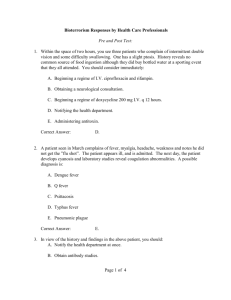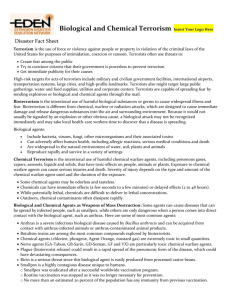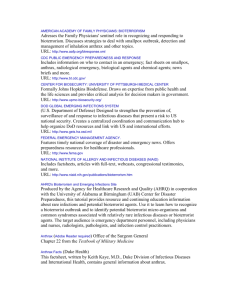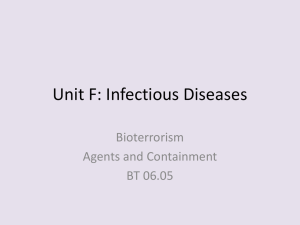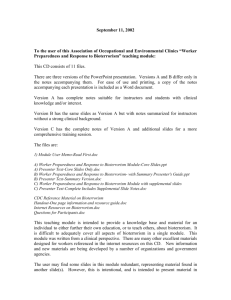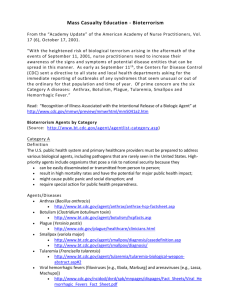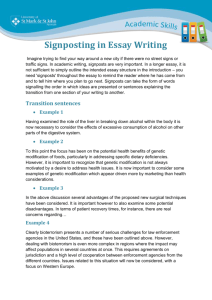Overview of Bioterrorism Agents Student Handbook
advertisement
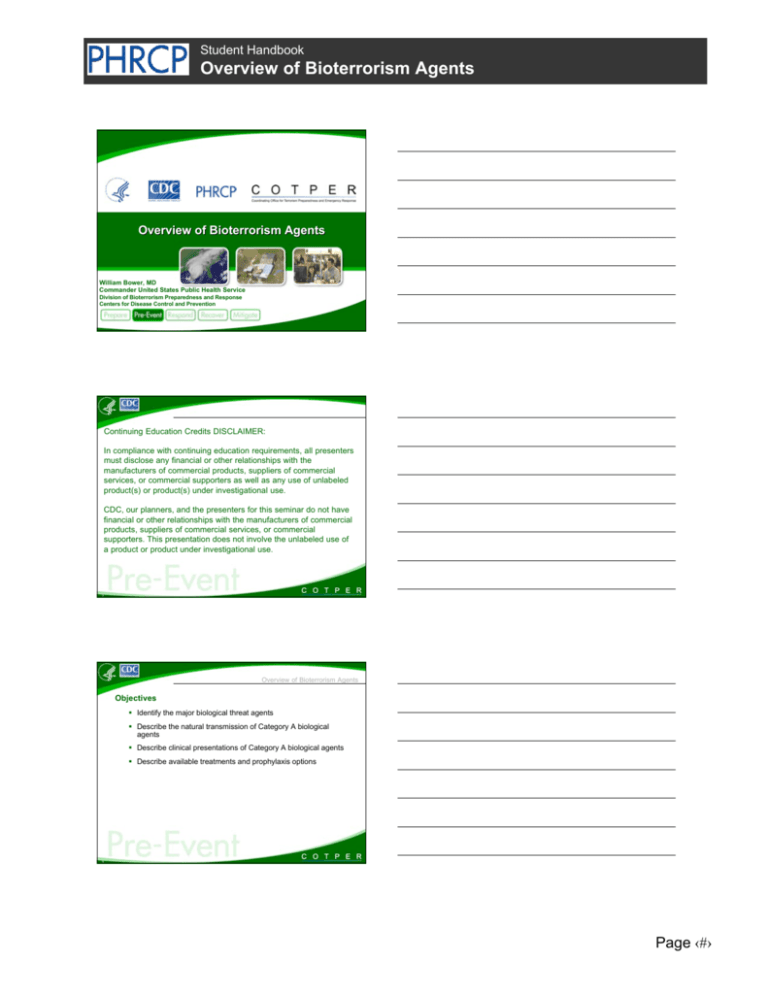
Student Handbook Overview of Bioterrorism Agents Overview of Bioterrorism Agents William Bower, MD Commander United States Public Health Service Division of Bioterrorism Preparedness and Response Centers for Disease Control and Prevention Continuing Education Credits DISCLAIMER: In compliance with continuing education requirements, all presenters must disclose any financial or other relationships with the manufacturers of commercial products, suppliers of commercial services, or commercial supporters as well as any use of unlabeled product(s) or product(s) under investigational use. CDC, our planners, and the presenters for this seminar do not have financial or other relationships with the manufacturers of commercial products, suppliers of commercial services, or commercial supporters. This presentation does not involve the unlabeled use of a product or product under investigational use. 2 Overview of Bioterrorism Agents Objectives Identify the major biological threat agents Describe the natural transmission of Category A biological agents Describe clinical presentations of Category A biological agents Describe available treatments and prophylaxis options 3 Page ‹#› Student Handbook Overview of Bioterrorism Agents Overview of Bioterrorism Agents Ideal Qualities for a Biologic Terrorist Agent High rate of illness among those exposed — High attack rate High rate of death among those who get ill — High case fatality rate Short time between onset of illness and death — Small window to start treatment Low level of immunity in the population 4 Overview of Bioterrorism Agents Ideal Qualities for a Biologic Terrorist Agent (cont) No effective or available treatment Can be transmitted person to person Easy to produce and disseminate Difficult to diagnosis either clinically or diagnostically (i.e. laboratory identification) 5 Overview of Bioterrorism Agents Epidemiological Clues What we look for… Large outbreak with high illness and death rate Single case of uncommon disease (e.g., Smallpox) Unusual symptoms or severity of illness Infection is non-endemic to region Unusual seasonal distribution Multiple simultaneous outbreaks in non-contiguous areas Sick or dying animals 6 Page ‹#› Student Handbook Overview of Bioterrorism Agents Overview of Bioterrorism Agents Bioterrorism Threats: Priority Biological Agents Bacterial Viral — Anthrax —Smallpox — Plague —Viral Hemorrhagic Fevers — Tularemia —Viral Encephalitis Toxins — Brucellosis — Q fever —Botulism — Other —Staph Enterotoxin B – – food borne pathogens waterborne pathogens —Ricin toxin —Tricothecene mycotoxins 7 Overview of Bioterrorism Agents Anthrax Gram positive spore forming bacterium Bacillus anthracis Primarily disease of herbivores which are infected by ingesting spores in soil Natural transmission to humans by contact with infected animals or contaminated animal products — “Woolsorter’s disease” Three forms of disease CDC: Gram stain of B. anthracis — Cutaneous — Inhalational — Gastrointestinal (GI) 8 Overview of Bioterrorism Agents Epidemiology of Transmission Direct contact Ingestion Cutaneous anthrax Gastrointestinal anthrax Inhalation Infected herbivores and soil are reservoir Pulmonary/ mediastinal anthrax 9 Page ‹#› Student Handbook Overview of Bioterrorism Agents Overview of Bioterrorism Agents Anthrax: Day 2-4 Day 6 Cutaneous Accounts for 80% of naturally occurring Anthrax cases Enters through openings in skin from abrasions, lacerations Day 10 20% progress to systemic form if untreated Most cases recover Eschar formation 10 Overview of Bioterrorism Agents Anthrax: Inhalational Inhalation of spores Incubation, 2-3 days (range up to 60 days) Spores engulfed by macrophages and transported to mediastinal and peribronchial lymph nodes Insidious onset: malaise, low grade fever, nonproductive cough Abrupt development of respiratory distress Hemorrhagic mediastinitis Hematogenous spread Meningitis in 50%, usually fatal 11 Overview of Bioterrorism Agents Anthrax: Pulmonary/Mediastinal Mediastinal widening from anthrax Normal chest x-ray 12 Page ‹#› Student Handbook Overview of Bioterrorism Agents Overview of Bioterrorism Agents Patient Care Inhalational Anthrax Ciprofloxacin 400 mg intravenous every 12 hours for adults Doxycycline 100 mg intravenous every 12 hours for adults and children > 8 yr and > 45 kg AND/OR 10 -15 mg/kg intravenous every 12 hours for children 2.2mg/kg every 12 hours for children < 8 yr (up to 200 mg/day) PLUS One or two additional anti-microbial agents effective against anthrax (e.g. imipenem, clindamycin, rifampin, macrolides) Additional issues Penicillin should never be used as a monotherapy If meningitis is suspected, an antibiotic with good CSF penetration should also be administered (e.g. rifampin or chloramphenicol) Supportive therapy for shock, fluid volume deficit and airway management may be needed. Drainage of pleural effusions may improve clinical outcome Anthrax Immune Globulin (AIG) can be used to neutralize anthrax toxin. 13 Overview of Bioterrorism Agents Anthrax: Post-Exposure Prophylaxis Start 60 days of oral antibiotics ASAP after exposure — Ciprofloxacin or Levofloxacin OR — Doxycycline OR — Amoxicillin or Penicillin (if known PCN sensitive) Vaccine — Can be given post-exposure in conjunction with antibiotics 14 Overview of Bioterrorism Agents Smallpox Variola virus, two forms of the disease: minor and major Spread via respiratory droplets or aerosols expelled from the oropharynx May also spread via direct contact Patients are most contagious during the time at which the skin rash is present Approx. 30% of patients exposed go on to develop the disease Approx. 30% mortality with ordinary smallpox 15 Page ‹#› Student Handbook Overview of Bioterrorism Agents Overview of Bioterrorism Agents Smallpox Characteristics Febrile Syndrome – occurring 1-4 days prior to rash. Classic Smallpox lesion – deep-seated, firm/hard, round, well-circumscribed; lesion may become umbilicated or confluent. 16 Overview of Bioterrorism Agents Smallpox Rash Chickenpox Rash 17 Overview of Bioterrorism Agents Smallpox Characteristics Febrile Syndrome – occurring 1-4 days prior to rash. Classic Smallpox lesion – deep-seated, firm/hard, round, well-circumscribed; lesion may become umbilicated or confluent. Lesion in Same Stage of Development – Evolve from macules _ papules _ pustules at the same time. Centrifugal distribution – First lesion on oral mucosa, face, or forearms. 18 Page ‹#› Student Handbook Overview of Bioterrorism Agents Overview of Bioterrorism Agents Smallpox vs. Chickenpox: Distribution 19 Overview of Bioterrorism Agents Smallpox Characteristics Febrile Syndrome – occurring 1-4 days prior to rash. Classic Smallpox lesion – deep-seated, firm/hard, round, well-circumscribed; lesion may become umbilicated or confluent. Lesion in Same Stage of Development – Evolve from macules _ papules _ pustules at the same time. Centrifugal distribution – First lesion on oral mucosa, face, or forearms. Lesion on palms and soles 20 Overview of Bioterrorism Agents Clinical Timeline for Smallpox Exposure Early Rash Phase Mucous membrane lesions Small red spots on the tongue and throat Lesions enlarge, ulcerate, then shed virus Infectious 24 hours before visible skin rash Incubation period 12 days (range 7-19 days) NOT Infectious Prodrome phase (2 - 4 days) Abrupt onset of fever >38.3°C Malaise/myalgia Headache Nausea/vomiting Backache Usually NOT Infectious Rash Phase (21 days) 1) macules 2) papules 3) vesicles 4) pustules 5) scabs Infectious until all scabs fall off 21 Page ‹#› Student Handbook Overview of Bioterrorism Agents Overview of Bioterrorism Agents Smallpox Progression Day 13 Day 8 Day 6 Day 4 Scabs Pustules “pocks” Vesicles Day 4 of rash Papules 22 Overview Bioterrorism Agents Smallpox: Medical Management Strict respiratory/contact isolation of patient — Patient infectious until all scabs have separated Treatment is supportive care only Antivirals are under evaluation — Cidofovir — ST246 23 Overview of Bioterrorism Agents Smallpox: Prevention and Control Immediate vaccination of ALL close contacts (< 6 ft) and ALL contacts of patients contacts (Ring vaccination) Vaccination within 4 days of exposure may prevent or lessen disease Contacts of Contacts Contacts of Case(s) Case(s) Mass vaccination may be necessary and/or everyone may want to be vaccinated 24 Page ‹#› Student Handbook Overview of Bioterrorism Agents Overview of Bioterrorism Agents Smallpox: Current Vaccine Live vaccinia virus Because it is a live virus, there can be adverse events from vaccination — Occurs mostly in immunologically suppressed persons Immunity is not life-long, but having been vaccinated in the past may reduce morbidity and mortality WHO 25 Overview of Bioterrorism Agents Plague Plague is a severe bacterial disease of humans and animals produced by the gram negative nonsporulating bacillus Yersinia pestis — Bite of a rodent flea that is carrying the plague bacterium, or by handling an infected animal — Hundreds of millions of people died when human dwellings were inhabited by flea-infested rats — Modern antibiotics are effective, but without prompt treatment the disease can likely cause illness or death 26 Overview of Bioterrorism Agents Types of Plague Three types: —Bubonic —Septicemic —Pneumonic 27 Page ‹#› Student Handbook Overview of Bioterrorism Agents Overview of Bioterrorism Agents Plague: Epidemiology of Natural Transmission A B Primary bubonic plague D D C Secondary plague cases Primary septicemic plague Primary pneumonic plague Flea vector such as Xenopsylla cheopis A B C Animal Reservoirs Routes of Plague Transmission A= Bite of Flea B = Contact with animal or carcass C = Inhalation of respiratory droplets D = Contact with sputum or fluid 28 Overview of Bioterrorism Agents Clinical Presentation of Pneumonic Plague Exposure Incubation Period Early Presentation Abrupt onset of fever, malaise, headache, myalgia Chest pain and dyspnea Tachypnea (particularly in young children) Productive cough (sputum may be purulent or watery, frothy, blood-tinged) Hemoptysis 1-6 days Antibiotic therapy in the first 24 hours can prevent septicemia, cardiorespiratory failure, shock, and death! Late Presentation Rapid progression to pulmonary disease/ARDS Pulmonary edema, dyspnea, cyanosis Meningitis may be a complication Hypotension, DIC, septicemia, and death Lab findings -- bacterial infection and sepsis Organism usually seen on sputum gram stain Mortality approaches 100% if untreated in 24 hours 29 Overview of Bioterrorism Agents Plague: Patient Care Early antibiotic treatment* is paramount to patient survival Adults: Streptomycin 1 gm IM b.i.d. for 10 days; Chloramphenicol 25 mg/kg IM or IV 4 times daily for 10 days Gentamicin 5 mg/kg IM or IV once daily for 10 days; Doxycycline 100 mg IV b.i.d. or 200 mg IV once daily for 10 days; Ciprofloxacin 400 mg IV b.i.d. for 10 days; Children: Streptomycin 15 mg/kg IM twice daily for 10 days (max 2 gm/day); Chloramphenicol 25 mg/kg IV 4 times daily for 10 days (max 4 gm/day) Gentamicin 2.5 mg/kg IM or IV 3 times daily for 10 days; Doxycycline 2.2 mg/kg IV twice daily for 10 days (max dose 200mg/day); Ciprofloxacin 15 mg/kg IV twice daily for 10 days (max 1 gm/day) *CDC recommends initiating treatment with two drugs believed effective against Y. pestis until antimicrobial susceptibility data is available on isolates. 30 Page ‹#› Student Handbook Overview of Bioterrorism Agents Overview of Bioterrorism Agents Plague: Prophylaxis Pneumonic plague contacts (transmitted via droplets) — Oral Doxycycline or Ciprofloxacin — For 7 days after last exposure Vaccine no longer manufactured 31 Overview of Bioterrorism Agents Botulism Caused by toxin from Clostridium botulinum Colorless, odorless and tasteless Lethal dose for 70kg human is 1ng/kg — Botulinum toxin is the most lethal neurotoxin known to man — Dispersal of aerosolized toxin, 1 gm of aerosolized toxin could kill up to 1.5 million people Seven toxin types — Human disease: A, B, E, and F — Animal disease: C, D, and G 32 Overview of Bioterrorism Agents Botulism: Epidemiology of Natural Transmission Toxin production in foods prepared or stored at ambient temperature Colonization and toxin production in an open wound Botulism: Acute, symmetric, descending flaccid paralysis with bulbar palsies C. botulinum Intestinal colonization and toxin production in susceptible infants and adults in the soil, flora and fauna 33 Page ‹#› Student Handbook Overview of Bioterrorism Agents Overview of Bioterrorism Agents Clinical Presentation of Botulism Exposure Descending Flaccid Paralysis Cranial Nerve Palsies Incubation Period Inhalational 24-72 hours Foodborne 18-36 hours (range 2 hours to 8 days) Dependent on toxin dose Symmetric Paralysis Voluntary Muscles Cranial Nerves III, IV, VI, VII, IX 1. 2. 3. 4. Blurry vision Diplopia Ptosis Expressionless Facies Regurgitation Dysarthria/Dysphagia Neck Shoulders Upper extremities Lower extremities BP often normal; Mental status normal 34 Overview of Bioterrorism Agents Botulism: Medical Management Early administration of antitoxin Supportive care —Monitoring respiratory function —Providing mechanical ventilation – May be needed for weeks or months 35 Overview of Bioterrorism Agents Botulism: Antitoxin Preferably within 24 hours of symptom onset Type of antitoxin based on type of botulism — Bivalent antitoxin specific to serotype A and B, — Monovalent antitoxin specific to serotype E, and — Heptavalent antitoxin specific against serotypes A, B, C, D, E, F, and G 1 vial per person Acts by binding free systemic toxin — Does not reverse paralysis already present 36 Page ‹#› Student Handbook Overview of Bioterrorism Agents Overview of Terrorism Agents Viral Hemorrhagic Fevers (VHF) Hemorrhagic fever viruses (RNA) belong to four taxonomic families: —Filoviridae (Ebola/Marburg) —Arenaviridae (Bolivian HF)) —Bunyaviridae (Congo-Crimean HF) —Flaviviridae (Dengue) Natural vectors – virus dependent —Rodents, mosquitoes, ticks No natural occurrences in U.S. 37 Overview of Bioterrorism Agents VHF as a Biological Weapon These viruses are considered suitable weapons because: — they have a low infectious dose — they cause high morbidity and mortality — they cause fear and panic in the general public — effective vaccines are either not available, or supplies are limited 38 Overview of Bioterrorism Agents Clinical Timeline for VHF Exposure External /Internal Hemorrhage • Ecchymosis Early Manifestations Incubation Period 2-21 days (depending on the virus) Later Manifestations In general: • High fever • • • • • Headache Myalgia Arthralgia Anorexia Varying degrees of nausea, vomiting and diarrhea • • • • • • • • • Petechiae Bleeding from puncture site Bleeding from nose and gums Hemorrhagic conjunctivitis Gastrointestinal bleeding Severe vaginal bleeding Pleural effusion Renal Failure Shock Laboratory Findings • Leukopenia or leukocytosis • Thrombocytopenia • Elevated Liver Function Tests • Anemia or Hemoconcentration • Prolonged PT, PTT 39 Page ‹#› Student Handbook Overview of Bioterrorism Agents Overview of Bioterrorism Agents Clinical Presentation of VHF Ecchymosis Petechiae Melena 40 Overview of Bioterrorism Agents VHF Clinical Management Aggressive supportive care with intravenous fluids, colloids, blood products as needed Specific therapy (ribavirin) may be helpful in bunyaviruses and arenaviruses Avoid IM injections or invasive procedures (due to bleeding) Strict aerosol precautions (i.e. respiratory isolation) 41 Overview of Bioterrorism Agents Sources of Information Centers for Disease Control (CDC) — www.cdc.gov CDC Emergency Preparedness — www.emergency.cdc.gov CDC Quarantine and Isolation — www.cdc.gov/ncldod/dp/index.htm 42 Page ‹#› Student Handbook Overview of Bioterrorism Agents Overview of Bioterrorism Agents Questions? 43 Continuing Education guidelines require that the attendance of all who participate in COCA Conference Calls be properly documented. ALL Continuing Education credits (CME, CNE, CEU and CHES) for COCA Conference Calls are issued online through the CDC Training & Continuing Education Online system http://www2a.cdc.gov/TCEOnline. Those who participate in the COCA Conference Calls and who wish to receive CE credit and will complete the online evaluation by July 31, 2008 will use the course code EC1265. Those who wish to receive CE credit and will complete the online evaluation between August 1, 2008 and July 1, 2009 will use course code WD1265. CE certificates can be printed immediately upon completion of your online evaluation. A cumulative transcript of all CDC/ATSDR CE’s obtained through the CDC Training & Continuing Education Online System will be maintained for each user. 44 CME: CDC is accredited by the Accreditation Council for Continuing Medical Education (ACCME) to provide continuing medical education for physicians. CDC designates this educational activity for a maximum of 1 Category 1 credit toward the AMA Physician's Recognition Award. Physicians should only claim credit commensurate with the extent of their participation in the activity. CNE: This activity for 1.0 contact hours is provided by CDC, which is accredited as a provider of continuing education in nursing by the American Nurses Credentialing Center's Commission on Accreditations. CEU: CDC has been reviewed and approved as an authorized provider by the International Association for Continuing Education and Training (IACET), 8405 Greensboro Drive, Suite 800, McLean, VA 22102. CDC has awarded 0.1 CEU to participants who successfully complete this program. CHEC: CDC is a designated provider of continuing education contact hours (CECH) in health education by the National Commission for Health Education Credentialing, Inc. This program is a designated event for the CHES to receive 1 Category I Contact Hour(s) in health education. CDC provider number GA0082. 45 Page ‹#›
